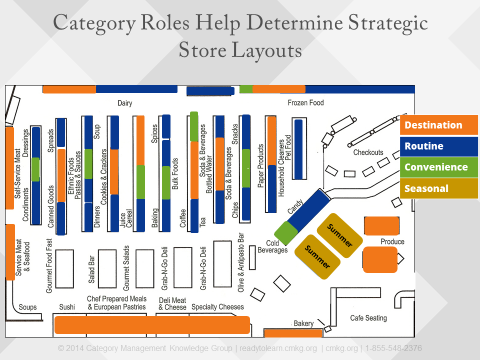Here’s why you shouldn’t treat all your categories the same…
Imagine a retailer who sells hundreds of categories and treats each of them exactly the same – including decisions on assortment, shelving, promotions and pricing. Remember – equal treatment would require the same number of resources and time spent against every category.
Sound like a good idea?
Absolutely not! Retailers need to assign roles across categories to get a broad look at their category mix, determine the category’s relative importance, and apply similar tactical strategies across categories with the same role. This is an important foundation of their overall Retailer strategy.
Here are some great resources from CMKG for you to get started on your learning journey:
Category Roles:- Category management training course preview (video)
- Complimentary download that reviews the roles of the category
- Certified course details
Before you determine roles for your categories, consider these 3 factors.
1. Category roles are assigned at a strategic corporate level
Assigning roles to categories requires broad perspective across a Retailer’s category mix to determine the category’s relative importance. This view will vary by channel, format and banner. In the Convenience channel, there are completely different role definitions (derived by NACS), driven by the significant differences in a Convenience store shopping trip.
For Retailers, categories that may play a destination role in a large Grocery format may have little importance in their Convenience format (think about Laundry Detergents as an example). These differences in roles will also affect the tactics at a category level.
Vendors need to understand that assigning category roles is based on the relative importance of the category to the total store – and not the relative importance of their brands to their total brand portfolio for the Retailer. If you think your category is destination, consider if it is in the top 15% of category sales for the total retail store (if it’s not then it’s most likely not destination).
2. Category roles help determine the strategic layout for your stores
Retailers need to think about how the Shopper will move through their store and figure out how to get them moving up and down the aisles (vs perimeter shopping only). Their overall plan should direct traffic flow so that Shoppers will shop the entire store.
You can balance and manage Shopper traffic flow by placing categories strategically within identified destination roles throughout the store and surrounding them with related routine and impulse categories.

3. Category roles set the stage for assortment, pricing and merchandising strategies
Retailers need to establish their own strategic guidelines and principles across the tactics based on the role that is assigned. For example, destination categories may have a broader assortment, more promotional activity and more competitive market pricing strategies. By applying these strategies broadly across categories within a specific role, it makes a Category Manager’s job much easier when they are making tactical choices for their categories.
To summarize — category roles are an important part of a Retailer’s strategic category management foundations. By assigning these roles and formalizing the tactical guidelines for each role, it ensures a more aligned and consistent approach to categories across the store.
If you’d like more information on Category Roles, we have a certified category management training course that will walk you through these 3 factors and more, so you can make the best decisions on assigning category roles.
|
$125 USD 30-day Access Hands-On Downloadable Reference Guide Knowledge Checks Course Test |



